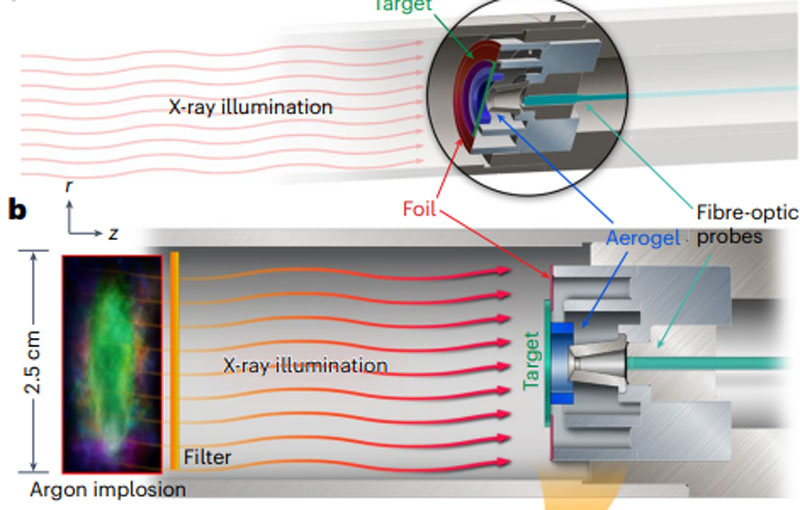Scientists from the United States conducted an experiment that proved the possibility of changing the trajectory of an asteroid dangerous to the Earth using a nuclear explosion. The researchers are not going to blow up the asteroid itself, leaving the spectacle of the debris flying away to the filmmakers. The asteroid should be affected by powerful ionizing radiation from a nearby nuclear explosion, evaporating its surface and creating a precisely calculated thrust vector.

Image source: Nature Physics, 2024
The experiment was carried out at Sandia National Laboratories in the USA. To do this, a group of scientists led by physicist Nathan Moore used the laboratory’s powerful X-ray machine, the so-called Z-machine. The researchers fired X-ray pulses at targets posing as quartz and fused silica asteroids. Asteroids tend to be high in silicates, so the targets on average matched the composition of most asteroids.
A target with a diameter of 12 mm was secured to the setup with metal foil. The radiation evaporated the foil, causing the asteroid model to seem to hover in free space and be hit only by the X-ray beam. The gas from the sputtered foil was diverted from the target so as not to contribute to the impulse from the effect of radiation on the target. What was important for scientists was the dynamics of not only the direct impact, but also the relatively long-term impact during the expansion of the substance (ionized gas or plasma) evaporated from the surface of the target. Since the shot and process lasted a fraction of a second, the free fall of the target after the foil evaporated could be neglected.
Measurements showed that quartz targets, after being shot with X-rays with a total intensity of 1.5 MJ, acquired a speed of 69.6 m/s, and fused quartz targets acquired a speed of 70.3 m/s, which corresponds with high accuracy to theoretical calculations using a digital model. Scaling up to asteroids 3 to 5 km in size, the promise is that a nearby nuclear bomb explosion near an asteroid will give it a speed of more than 10 cm/s in the desired direction, which is guaranteed to deviate its trajectory.
Such asteroids can fall to Earth once every 250–500 million years. This is a very small, but non-zero probability of the destruction of earthly civilization, which forces us to look in advance for ways to influence asteroids dangerous to our planet. So far, scientists together with NASA have conducted only one full-scale experiment to change the trajectory of an asteroid by impact. The DART kamikaze probe struck the Dimorph asteroid, causing it to change its orbital motion around its central pair, the Didymus asteroid.
In general, impacting a dangerous asteroid is risky in itself, since it can turn one dangerous asteroid into a swarm of equally dangerous and poorly tracked rocks. In the same way, a direct hit by an atomic bomb on an asteroid is a risk of the same nature. Exposure of an asteroid to powerful ionizing radiation, which will create thrust from the evaporated material on its surface, is a more predictable way to force a celestial body to change its orbit. A laboratory experiment proved the feasibility of this method. But it is unlikely that it will come to experiments. Currently, international agreements prohibit nuclear weapons from being launched into space in any form.